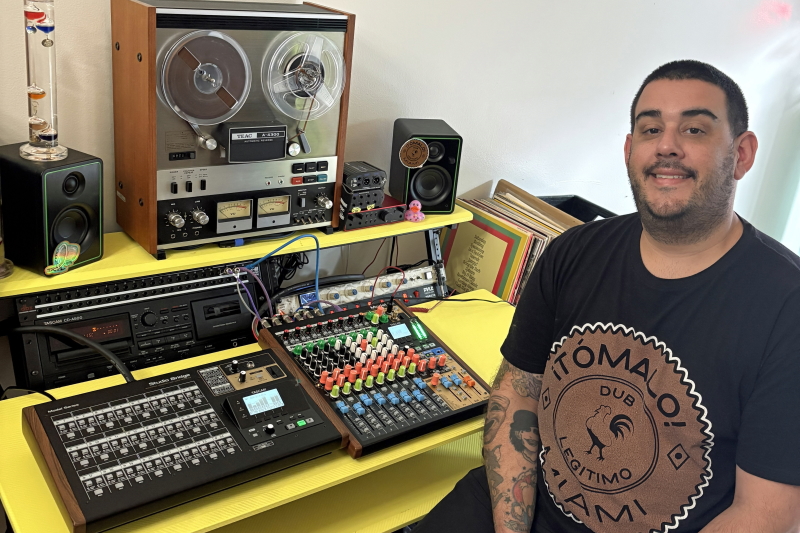TASCAM's Model 12 and Studio Bridge used by Tomas Bringas

Much of today’s contemporary music production stems from the process of ‘breaking the rules’ that commonly apply to conventional mixing and recording. It is this pioneering spirit that often opens the doors to new opportunity, and this is precisely what defines the music of Tomas Bringas, also known as Tómalo Dub. Pushing musical boundaries requires both vision and imagination, and to reach his destination, Bringas relies on the freedom of expression made possible by his Model 12 12-Track Digital Recording Mixer with DAW Controller and Audio Interface along with his Studio Bridge 24-Track Recorder and USB Audio Interface with MIDI - both from TASCAM.
Born to Cuban parents, Bringas grew up skateboarding and playing in punk, ska, and rock bands. He has a passion for dub reggae, a genre of popular dance music made from remixing reggae recordings that he ‘personalizes’ with a touch of punk influence. Bringas recently had the pleasure of tracking singer/songwriter Giulianna Cobolli with his Model 12 and is in the process of finishing some touches on the dub version of Dancing Without You, which is expected to be released soon. He discussed his experience using his TASCAM gear.
“I usually start on the Model 12 or in a DAW (hybrid dub mixing),” Bringas explains. “The Model 12 is the only mixer that, right out of the box, enables you to track to it as if it was a cassette-based TASCAM Portastudio - all while providing the convenience of having the ability to save to SD card, which is great for moving your work between different pieces of equipment or to a DAW. The Model 12 gives me the ability to use compression, reverb, delay, chorus, and other effects, along with 3-band EQ on individual channels and a 3-band mastering EQ. It’s also a powerful audio interface for connecting with other types of equipment. From there, I can transfer everything to my Studio Bridge, which serves as the main production tool for fine-tuning the music. I use the Studio Bridge to help make judgements in balance and to store all my songs and stems - almost like a dub stem dictionary. Together, these two recording systems provide the ability to mix and contour the music as I envision it while seamlessly interacting with other types of gear as well.”
When asked about those Model 12 features he finds most beneficial for his manner of working, Bringas offered the following comments, “For starters, the system’s size is perfect for me. The Model 12’s faders give me the ability to have a good sense of control over my mixes without having so many that it becomes confusing in terms of signal routing management - all in a size that doesn’t overcrowd my studio. Equally important, these number of faders make you think carefully about what musical elements you want the most control over. The fact that the Model 12 also supports HUI/MCU protocol emulation makes it easy to interface the console with other components such as a DAW. And the console’s support for SD cards simplifies the process of moving data between various devices.”
While Bringas has owned his Model 12 for roughly two years, his Studio Bridge has only been part of his setup for about three months. “The DB25 analog line level input and output capability on the Studio Bridge has proven very useful,” Bringas explained. “This is a great feature for interfacing an analog mixing console into the equation so that you gain the benefits of digital recording while maintaining the warmth of analog. Like the Model 12, the Studio Bridge also supports the use of SD cards, so the process of moving my data between this and the Model 12 couldn’t be easier. You insert the card into the reader, drag and drop the data, and then move the card between the two recording systems.”
Bringas shared an experience where the SD card capability of both the Model 12 and Studio Bridge really had a profound impact on his ability to complete a project. “For the song Hola Buenos Dub by Jacuzzi Fuzz, they really had a lot of tracks. I spent about 2 days trying to figure out how I was going to upload all these tracks to the various channels of the Model 12. Had it not been for the wonderful SD card technology, the trial-and-error process of bouncing and listening back to all the various stems would have been redundant to say the least.”
With the level of sophistication found in today’s musical electronics, questions frequently arise, so capable and responsive customer support services are crucial. When asked about his experience with TASCAM in this regard, Bringas offered the following thoughts. “TASCAM’s support services have been terrific,” he said. “Not only do they make terrific products, they care about their customers, so you can count on getting your questions answered.”
Before turning his attention back to his current recording project, Bringas offered these final thoughts regarding his TASCAM experience, “In a world where music production gear is more about bells and whistles, I am grateful TASCAM has made the Model 12 and Studio Bridge. They are true workhorses. I believe the Model 12 is in many ways the standard for home recording and I consider it to be worth every penny.”
 How to resolve AdBlock issue?
How to resolve AdBlock issue?